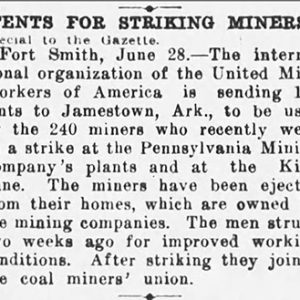calsfoundation@cals.org
Wheelbarrow Strike of 1915
The Wheelbarrow Strike of 1915 was a union-management conflict centered upon Wheelbarrow Mine in Johnson County’s Spadra coal fields. Lawsuits subsequent to the strike remained in the court system until 1928 and resulted in the United Mine Workers (UMW) being found guilty of violating the Sherman Antitrust Act.
Many of the miners in Johnson County were members of local unions formed by the regional District 21 of the UMW, and the Wheelbarrow Mine operated under union agreements. Complications with a small strike in 1910 prevented a new union contract from being created, and the Wheelbarrow mine came under the control of the Pennsylvania Mining Company (PMC), which had been founded by the Pennsylvania businessman James Gearhart earlier that year. Because of the lease agreement under which PMC had begun its operations, it quickly stopped applying union prescriptions to the Wheelbarrow Mine.
Obviously, most union workers resented this change in policy, and many quit their mining jobs, going back to farming. Others openly opposed PMC’s anti-union stance, especially Jeff McAnally and Sam McGuire, who took active roles in the retaliation efforts. During the winter of 1910, PMC replaced many of its workers with Eastern European immigrants who, because of weak English skills, were often tricked by union members into leaving the state to other mines. The PMC would then bring the immigrants back and direct them to the Wheelbarrow Mine. Between 1910 and 1915, 1,500 immigrants came through and worked in the mine.
As disdain among union workers increased, rumors of violence started circulating, and lawlessness made its way into the mining camp. There were reports of rowdy drunkenness, and gunshots were often heard—there were even vague reports of people being killed. Although most of this violence was not directed at the management, the situation with PMC did nothing to quell the rowdiness of the miners. At first, PMC ignored this behavior, but as the threat of violence grew, they hired guards to keep the miners’ behavior in check. One purpose for having guards was to isolate miners from local union activity. But the presence of a guard did nothing to stop the rowdiness and instead created even more resentment among the workers.
By 1913, union leaders called PMC’s treatment of workers a manifestation of “industrial warfare.” The first instance of violence between union and nonunion supporters occurred in July 1914. This provoked PMC to hire more guards to watch the Wheelbarrow Mine, and everyone braced themselves for increased violence. However, before another outbreak, the Arkansas legislature, with Act 49 of 1915, shook things up by amending a law that regulated how each miner’s coal was to be weighed, a change that lowered workers’ salaries.
This was the final straw, and on Tuesday, June 9, 1915, the workers went on strike, organized by UMW officers Jim Fern, Jim Mooney, Pete Hanratty, and George Lindsey. The UMW’s charges against PMC included the company’s use of unskilled labor, low wages, assigning too many people to each coal room in the mine, fifteen- to eighteen-hour workdays, and the availability of credit only at a company store that sold goods at higher prices than normal. PMC immediately evicted all workers from company-owned houses, and the miners set up a colony of tents, which only provoked more lawlessness. Yet again, rumors of violence made their way around the tent colony and the mines. In August 1915, a bridge leading to the mine was blown up. No one was ever found responsible, but the event heightened animosity, and accusations were thrown back and forth.
The strike finally ended when PMC decided to file a lawsuit against UMW, challenging the legality of its philosophies and methods. A year later, PMC had gone bankrupt, and its business in Arkansas was finished. UMW did not have time to celebrate, however, as the litigation continued. PMC made charges against the union, stating that it had committed terrorism, intimidation, trespassing, public disturbances, and violence. Additionally, the company accused the UMW of keeping workers from their jobs, costing PMC $75,000 every year. In April 1920, Judge Frank Youmans of Fort Smith (Sebastian County) ruled in favor of PMC. Immediately, the UMW filed a summation of its grievances, arguing for its powers as a union and that PMC’s evidence had been hearsay. In March 1926, after the Court of Appeals ordered a retrial, a reversal ruled that the UMW had not, indeed, broken the Sherman Antitrust Act, as PMC had accused.
However, PMC immediately filed its own summation, and, in 1928, the original verdict was reinstated, ending thirteen years of litigation. The case represented a national trend of union coal companies being unable to compete with nonunion ones. It was only one example of unions fighting for their rights during the early twentieth century in Arkansas.
For additional information:
Acts of Arkansas 1915. Act 49, pp.157–159, Approved February 16, 1915.
Lewis, Susanne S. “The Wheelbarrow Strike of 1915: Union Solidarity in Arkansas.” Arkansas Historical Quarterly 43 (Autumn 1984): 208–221.
Bernard Reed
Little Rock, Arkansas
 Early Twentieth Century, 1901 through 1940
Early Twentieth Century, 1901 through 1940 Labor Movement
Labor Movement Wheelbarrow Strike Article
Wheelbarrow Strike Article 




Comments
No comments on this entry yet.